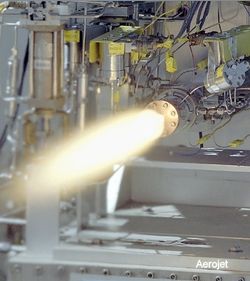Mon, Jul 06, 2009
Engine Designed For Lunar Ascent
 Aerojet announced this week that it
has completed manufacturing and assembly of an advanced 5,500-lbf
Liquid Oxygen (LOX) Liquid Methane (LCH4) rocket engine. Aerojet
will soon begin testing this advanced engine to provide data that
will validate the design features necessary to extend the
technology development of next-generation propulsion systems being
developed by NASA.
Aerojet announced this week that it
has completed manufacturing and assembly of an advanced 5,500-lbf
Liquid Oxygen (LOX) Liquid Methane (LCH4) rocket engine. Aerojet
will soon begin testing this advanced engine to provide data that
will validate the design features necessary to extend the
technology development of next-generation propulsion systems being
developed by NASA.
LOX Methane technology development focuses on rocket propellants
that are non-toxic as well as higher performing than many historic
propellant combinations. The 5,500-lbf Liquid Oxygen Liquid Methane
development engine is funded by the Propulsion and Cryogenics
Advanced Development Project (PCAD), under NASA's Exploration
Technology Development Program (ETDP). ETDP's role is to develop
and mature the necessary technologies to support flight systems in
NASA's Constellation Program, which includes engine development for
future lunar landers.
The lunar lander will be required to
send human explorers to the moon and return them to Earth. Unlike
the lunar missions during the Apollo program which encompassed days
on the moon, the missions anticipated for the lander may establish
a lunar outpost and extend lunar missions to months at a time.
The lunar lander is comprised of a descent and an ascent stage.
The descent stage will house the majority of the propellant, power
supplies and breathing oxygen for the crew. The ascent stage will
house the astronauts, their life-support equipment and necessary
fuel. The ascent main engine is anticipated to be expendable,
high-performance and pressure-fed, with the primary function of
powering an ascent module (AM) from the lunar surface into lunar
orbit for rendezvous with the Orion Crew Exploration Vehicle
(CEV).

File Photo
Multiple vehicle study activities have
shown that a cryogenic Liquid Oxygen (LOX)/Liquid Methane (LCH4)
propellant combination provides advantages for long duration
storage in space and for the ability to be extended for future
missions to Mars. This propellant combination is also being studied
as a promising option for the lunar lander's ascent stage due to
potential savings in overall systems mass when compared to
conventional propellant (hypergolic) systems. This new Liquid
Oxygen/Liquid Methane ascent main rocket engine is not as mature as
the conventional hypergolic systems. It uses non-toxic propellants
not previously used for this application and therefore tests are
needed to provide the critical design data. The Aerojet 5,500-lbf
Liquid Oxygen/Liquid Methane rocket engine program is designed to
provide the critical data for the AM application.
After Aerojet's initial tests, the engine will be delivered to
NASA's White Sands Test Facility in Las Cruces, New Mexico, where
the engine will be tested at a simulated altitude with a large
nozzle for performance characterization and for a long duration to
demonstrate the design's thermal adequacy.
More News
The Industry Continues to be Rocked By Some Questionable Operations Recent investigations and a great deal of data has resulted in ANN’s SportPlane Resource Guide’s rep>[...]
Make Sure You NEVER Miss A New Story From Aero-News Network Do you ever feel like you never see posts from a certain person or page on Facebook or Instagram? Here’s how you c>[...]
Visual Approach Slope Indicator (VASI) An airport lighting facility providing vertical visual approach slope guidance to aircraft during approach to landing by radiating a directio>[...]
Airport Marking Aids Markings used on runway and taxiway surfaces to identify a specific runway, a runway threshold, a centerline, a hold line, etc. A runway should be marked in ac>[...]
Aero Linx: The Skyhawk Association The Skyhawk Association is a non-profit organization founded by former Skyhawk Pilots which is open to anyone with an affinity for the A-4 Skyhaw>[...]
 Unfortunate... ANN/SportPlane Resource Guide Adds To Cautionary Advisories
Unfortunate... ANN/SportPlane Resource Guide Adds To Cautionary Advisories ANN FAQ: Turn On Post Notifications
ANN FAQ: Turn On Post Notifications ANN's Daily Aero-Term (04.29.24): Visual Approach Slope Indicator (VASI)
ANN's Daily Aero-Term (04.29.24): Visual Approach Slope Indicator (VASI) ANN's Daily Aero-Term (04.28.24): Airport Marking Aids
ANN's Daily Aero-Term (04.28.24): Airport Marking Aids ANN's Daily Aero-Linx (04.28.24)
ANN's Daily Aero-Linx (04.28.24)




